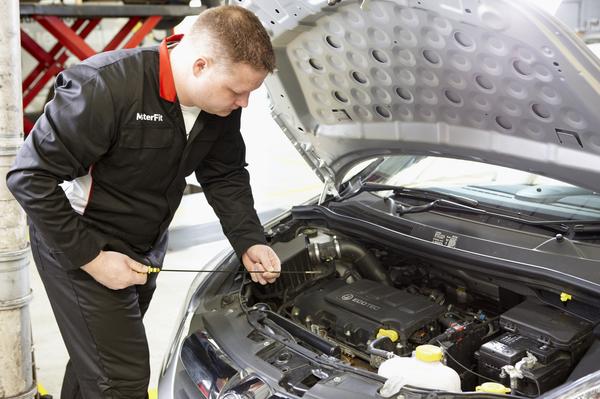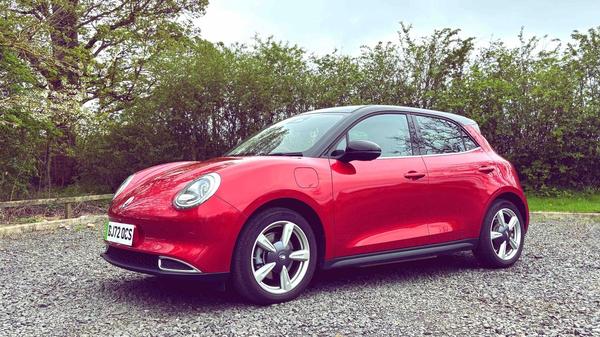Guide
Everything you need to know about servicing and maintaining a lease car
Here’s all the info you’ll need on car servicing and maintenance packages, the costs involved, and what ‘fair wear and tear’ means.


Words by: Mark Nichol

Additional words by: Andrew Woodhouse
Last updated on 31 May 2024 | 0 min read
Leasing a car should be easy, but you might have heard terms like “fair wear and tear” and “maintenance package” and wonder what they mean. We’ll explain these and more here, to help you make an informed choice if you’re considering leasing a new car.
The idea behind leasing – also known as ‘Personal Contract Hire’ (PCH) – is to make getting a brand-new car as simple and cost-effective as possible. There's much more detail about leasing in this article, but in short, leasing allows you to set up a manageable monthly payment that covers most of the cost of running a new car. At the end of the lease, you simply hand the car back. As with any car, new or used, it’s very important to look after it during the time you have it. It’ll need servicing at a certain age or mileage, and it could need replacement parts that wear out as you drive the car – like tyres, wipers and brake pads. It’ll also need a yearly MOT once it’s three years old For those reasons you can choose to include a ‘maintenance package’ with your monthly lease payment, which covers the cost of that stuff. You might sometimes see it called a 'servicing plan' or something similar, but it’s basically the same thing.
The idea behind leasing – also known as ‘Personal Contract Hire’ (PCH) – is to make getting a brand-new car as simple and cost-effective as possible. There's much more detail about leasing in this article, but in short, leasing allows you to set up a manageable monthly payment that covers most of the cost of running a new car. At the end of the lease, you simply hand the car back. As with any car, new or used, it’s very important to look after it during the time you have it. It’ll need servicing at a certain age or mileage, and it could need replacement parts that wear out as you drive the car – like tyres, wipers and brake pads. It’ll also need a yearly MOT once it’s three years old For those reasons you can choose to include a ‘maintenance package’ with your monthly lease payment, which covers the cost of that stuff. You might sometimes see it called a 'servicing plan' or something similar, but it’s basically the same thing.
What is car maintenance?
A car is full of moving parts that need regular maintenance to make sure they keep operating smoothly and efficiently. Consumables like engine oil and washer fluid should be topped up or replaced periodically, too. Ignoring these things, even with a newer car, can lead to problems down the line that can be expensive to rectify.
Adding a maintenance package to a lease means you’ll pay a little extra per month, but it covers the cost of servicing, any MOT needed within the length of the contract, tyres, routine maintenance, and the labour associated with those things.
Adding a maintenance package to a lease means you’ll pay a little extra per month, but it covers the cost of servicing, any MOT needed within the length of the contract, tyres, routine maintenance, and the labour associated with those things.
What does car maintenance include?
Exactly what is covered in a maintenance package varies between providers, so always check exactly what your lease contract will include before committing. Generally, though, maintenance covers repairs or replacement for ‘fair wear and tear’ parts. (We’ll come to what fair wear and tear means further down.) It usually includes things like brake pads, exhausts, windscreen wipers and tyres. Some maintenance packages include breakdown cover, too.
You can find out all about Auto Trader Leasing and how it works here. Maintenance doesn’t cover accidental damage, and it doesn’t cover mechanical or software faults, defects or malfunctions – those issues will be covered by the manufacturer’s warranty. For more info, here's our article on exactly what cover you have when you buy a car.
You can find out all about Auto Trader Leasing and how it works here. Maintenance doesn’t cover accidental damage, and it doesn’t cover mechanical or software faults, defects or malfunctions – those issues will be covered by the manufacturer’s warranty. For more info, here's our article on exactly what cover you have when you buy a car.

Cost of car maintenance
It’s of course entirely up to you whether to include a maintenance package with your lease deal. Without one, you’ll have to pay separately for routine maintenance, servicing, and any replacement tyres or MOT tests you might need.
As a rough guide, a mid-range tyre will cost something like £120 including fitting, and the average servicing cost is somewhere between £200 and £400 – but these costs can vary significantly depending on the complexity, price and performance of your car. An MOT test is currently pegged at £54.85 for any car. So, a sensible thing to do is to work out what the additional cost of a maintenance package will be over the entire length of your lease, then compare that to what you might end up paying out without one. The additional monthly cost of a maintenance package will correlate to the price of the car, the length of the lease you want to take, and the annual mileage you’ll do; the maintenance payment for a high-performance car leased over four years and driving 20,000 miles per year will be significantly higher than for a small hatchback leased for two years and 6,000 miles. There’s some guesswork involved, and a bit of luck – you can’t account for things like tyre punctures – but you can look at the specific costs of your particular car and make a judgement. It’s worth saying, though, that the convenience of spreading the payments out, and not being hit with unexpected bills through the contract, adds value in itself.
As a rough guide, a mid-range tyre will cost something like £120 including fitting, and the average servicing cost is somewhere between £200 and £400 – but these costs can vary significantly depending on the complexity, price and performance of your car. An MOT test is currently pegged at £54.85 for any car. So, a sensible thing to do is to work out what the additional cost of a maintenance package will be over the entire length of your lease, then compare that to what you might end up paying out without one. The additional monthly cost of a maintenance package will correlate to the price of the car, the length of the lease you want to take, and the annual mileage you’ll do; the maintenance payment for a high-performance car leased over four years and driving 20,000 miles per year will be significantly higher than for a small hatchback leased for two years and 6,000 miles. There’s some guesswork involved, and a bit of luck – you can’t account for things like tyre punctures – but you can look at the specific costs of your particular car and make a judgement. It’s worth saying, though, that the convenience of spreading the payments out, and not being hit with unexpected bills through the contract, adds value in itself.

Servicing a leased car
This probably goes without saying, but having your car serviced regularly is essential. Not only does it help avoid unexpected repair work, but it keeps your car running as it should be. You risk breaking the terms of the manufacturer warranty, and voiding your lease contract, of you don’t have your car serviced when it should be. Plus, any minor issues identified during servicing can be repaired at the time, which will prevent the problem getting worse and being more expensive to repair down the line.
Servicing intervals vary from model to model, but generally a car will need servicing once every 12 months or 12,000 miles, whichever comes first. All new cars will tell you when they’re due a service – on the instrument panel or central touchscreen – but it’s always worth checking your particular car’s servicing schedule. You'll find it in the car's log book or on the manufacturer website.
Servicing intervals vary from model to model, but generally a car will need servicing once every 12 months or 12,000 miles, whichever comes first. All new cars will tell you when they’re due a service – on the instrument panel or central touchscreen – but it’s always worth checking your particular car’s servicing schedule. You'll find it in the car's log book or on the manufacturer website.

Can I have my leased car serviced anywhere?
While it’s usually advisable to have a car serviced at a franchised dealer, you can have your leased car serviced at any garage that is VAT registered and uses genuine manufacturer like-for-like parts. Again, check with your lease provider before committing if you’re not sure. Having your car serviced by a non-registered garage will void your manufacturer warranty and break the terms of your lease contract. Make sure your car’s logbook is stamped when the service is complete, too.
What is fair wear and tear
“Fair wear and tear” is a broad term which acknowledges that a car can’t possibly be in ‘showroom’ condition when it’s handed back after thousands of miles on the road. It’s designed to protect the leaseholder from unreasonable extra charges when a lease contract ends.
But because it can seem a bit vague, lease providers will pin down exactly what fair wear and tear means as far as possible. It varies slightly from provider to provider, but things like worn tyres, superficial interior and exterior scratches (that can be polished out), and discolouration or creasing on leather seats – they’ll all be classed as fair wear and tear, usually. We have a full guide on fair wear and tear here.
But because it can seem a bit vague, lease providers will pin down exactly what fair wear and tear means as far as possible. It varies slightly from provider to provider, but things like worn tyres, superficial interior and exterior scratches (that can be polished out), and discolouration or creasing on leather seats – they’ll all be classed as fair wear and tear, usually. We have a full guide on fair wear and tear here.

Returning your lease car
Your lease car will undergo an inspection when you hand it back, so it’s a good idea to check the car thoroughly a month or two prior, so that anything you think will be problematic can be fixed. It’s often cheaper to organise repairs yourself than it is to pay the lease provider’s charges.
Faults to look out include: • Rust, corrosion or significant paint discolouration • Cracks in windows, lights or mirrors • Burns or tears in interior upholstery • Damage to the vehicle’s underside • Damaged or missing vehicle documents Don’t try to repair the car yourself. A professional will be able to complete the work to the required standard and can provide a full warranty, which may be required by the leasing company. The leasing company should tell you whether they’re going to charge you for damage within four weeks of returning the car. You have the right to query any charges. Find car leasing deals on Auto Trader.
Faults to look out include: • Rust, corrosion or significant paint discolouration • Cracks in windows, lights or mirrors • Burns or tears in interior upholstery • Damage to the vehicle’s underside • Damaged or missing vehicle documents Don’t try to repair the car yourself. A professional will be able to complete the work to the required standard and can provide a full warranty, which may be required by the leasing company. The leasing company should tell you whether they’re going to charge you for damage within four weeks of returning the car. You have the right to query any charges. Find car leasing deals on Auto Trader.